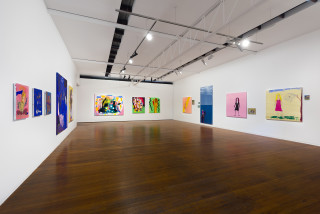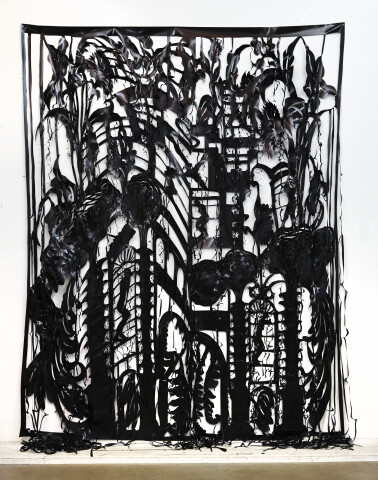Ten of Roslyn Oxley9 Gallery's artists make sense of our current state of affairs. With unexpected materials and exciting aesthetics, we are presented with alternate visions and challenging responses to our world.
Exhibition Dates: 7 December – 23 December 2017
‘The opinion that art should have nothing to do with politics is itself a political attitude.’
—George Orwell
‘State of Play’ concerns the current state of our world. Globally, a pervading sense of uncertainty continues to afflict our consciousness. With Trump’s rise to power and Britain’s exit of the EU, with no cohesive decisions made on climate change, equality of resources or immigration and as the historic clashes over issues of race, gender and sexuality, once thought to be put to bed, have arisen again with fervent debate, we try to make sense of things. In State of Play ten of Roslyn Oxley9 Gallery artists make sense of our current state of affairs. With unexpected materials and exciting aesthetics we are presented with alternate visions and challenging responses to our world.
These art works respond to and are shaped by the ‘state of play’ in which they are produced – provoking us to address current issues with renewed energy. They also provide us with moments to reflect, to breathe and exit the turmoil if only for glimpses. Some works were produced years before the current global ennui, yet the sentiments and issues remain vitally relevant, perhaps more pressing as the climate continues to warm and political uncertainty permeates.
We are inspired, challenged and pushed by these artists to keep questioning, keep investigating, revealing and compelling us to question the world in which we live, to keep searching for answers.
Marley Dawson’s sculptures directly question the role of traditional modes of agriculture - factory or mass-production are challenged through Dawson’s engineered microcosms of biodynamic farming. We are exposed to environmentally conscious farming theories, particularly those espoused by Rudolf Steiner - an early environmentalism following the industrial revolution that focuses on spirit legacies confronting modern ‘chemical farming.’
The daughter of an industrial chemist, Caroline Rothwell poses questions regarding humankind’s control of nature, continuing her investigations into geo-engineering or the science of manipulating the earth’s climate to circumvent global warming. Her PVC works, an industrial plastic left in its natural state, form stunning maps for us to navigate current topics on the natural and the man-made.
In another clever de-contextualisation of functional material, Bill Culbert imbues recycled plastic bottles with a transformative energy. Fluorescent light gives mystic life to symbols of mass-production as this artist’s use of found or recycled materials makes the viewer acutely aware of the effect of mass-production and consumerism on the environment.
James Angus’ Bicycles (2007) comprises three bicycles in one, playfully disturbing our expectations of the familiar. Like Duchamp’s Nude Descending a Staircase, No. 2 (1912) perhaps it is three bikes, blurred into one, brimming with potential energy and dynamism, challenging our expectations of the material world.
Faithful reproductions of recognisable objects in polyurethane resin allow Hany Armanious to invert our perception of the found object and reveal humankind’s ability to manipulate expected norms.
Callum Morton’s low-rent signs immediately bring the branding exercise of the Warhol era to mind, raising the low-budget to the high-class in playful jest, yet reminding us strongly in Immigration Services (2012) that issues of immigration have not dissipated, a sentiment stridently pertinent in 2017.
Fiona Hall’s first solo exhibition at Roslyn Oxley9 gallery in 1995 with ‘the price is right’ blatantly references our relationship to consumerism. Mass-produced, throw-away goods, transfigured and magnified first through hand-made aluminium models, then reproduced as a polaroid photograph, offer a personal discourse for banal objects. Making reference to the female body, 2017’s gender politics seep to the surface.
Kathy Temin’s Black Gardens (2013) are monuments to loss and remembrance: fur topped gardens that reference Temin’s dialogue with her familial history as the daughter of a Holocaust survivor. Equally the body is implied and tactile, gender non-specific and highlights current thought surrounding gender and sexuality. As the sound absorbing fabric soothes insecurity, we are also offered a quiet respite and space for reflection.
With measured tactility, Callum Morton’s iconic Cover Up series presents shrouded objects energised by what is invisible, by the potentiality of the hidden content. The act of concealment makes the elusive objects more enticing: faces are obscured, forgotten monuments are covered symbols for power and victory, ultimately providing the artist’s anarchic salute to existing modes of power. As we begin to recognise the soft outline of the most caricaturised hairstyle in modern time, the shock leaves us gasping for air.
Providing relief amongst the global chaos, Mikala Dwyer’s constructivist temple beckons: a beacon of hope, its light guiding us forward. Shining beneath a skin lampshade, the secular totems provide remedy for this global malaise. Her soul lamps soothe and fascinate in equal measure. These soft illuminations, a skin-body stretched over bulbs, are an emergency lamp for the soul, relief for society’s ills. Dwyer also provides an opportunity to make changes. In Letterbox Saint Jude (2010/2017), the Patron Saint of Lost Causes encased in fluoro will accept letters or prayers from the viewer.
Dale Frank’s sumptuous and dripping paint works, like magic colour-spells, transport us through their other-worldly aura. With scientific precision, Frank has been experimenting with picture surfaces for decades. The temperature and speed of pour allow us to question the role of the technology of painting, and, as our society speeds forward with scientific achievements and technological advancements, so, too, does art move forward with it, as processes become more complex and intangible.
While what is at play or at stake refers to the political landscape, to the forces at play on our environment, play in art can be quite different. In the face of foreboding questions, we have art to remind us of our humanity, our ability to be entertained, to laugh, to cry and keep hope in increasingly challenging times.
—Victoria Scott


extruded aluminium, fixings, brass, motor, controllers
195 x 60 x 60 cm

extruded aluminium, fixings, brass, cow horn, earth, controller, actuator
195 x 60 x 60 cm

extruded aluminium, fixings, brass, copper, domesticated animal skull (sheep), oak bark, glass, polyurethane, earth, pump, controller, rainwater
195 x 60 x 60 cm

varnish under Epoxyglass on Perspex
200 x 200 cm

varnish and Epoxyglass on perspex
200 x 180 cm

varnish under Epoxyglass on Perspex
200 x 200 cm

fluorescent light, electrical cords, black plastic bottles (5 litre)
33 x 120 x 11 cm

wood, metal, fabric, clay, glass, leather, plant matter, crystal, porcelain, light
200 x 100 x 90 cm; (Installation dimensions)



cast polyester resin, cast pigmented polyurethane resin, electric motor
225 x 35 x 35 cm

wood, steel, synthetic fur and filling
227 x 158 x 370 cm; (installation dimensions)
 Group Show, Works on Paper
Group Show, Works on Paper
Roslyn Oxley9 Gallery, 2024-25
 Group Show, The First 40 Years
Group Show, The First 40 Years
Roslyn Oxley9 Gallery, 2024
 Group Show, The Winter Bride
Group Show, The Winter Bride
Roslyn Oxley9 Gallery, 2023
 Group Show, A Painting Show
Group Show, A Painting Show
Roslyn Oxley9 Gallery, 2020-21
 Group Show, The Like Button
Group Show, The Like Button
Roslyn Oxley9 Gallery, 2018-19
 Group Show, State of Play
Group Show, State of Play
Roslyn Oxley9 Gallery, 2017
 Group Show
Group Show
Roslyn Oxley9 Gallery, 2016
 Group Show
Group Show
Roslyn Oxley9 Gallery, 2015
 Group Show, Never-Never Land (A Collaboration with Utopian Slumps)
Group Show, Never-Never Land (A Collaboration with Utopian Slumps)
Roslyn Oxley9 Gallery, 2014
 Group Show, Dawson, Griggs, Moore
Group Show, Dawson, Griggs, Moore
Roslyn Oxley9 Gallery, 2013
 Group Show, Cronies
Group Show, Cronies
Roslyn Oxley9 Gallery, 2012
 Group Show, Groups Who
Group Show, Groups Who
Roslyn Oxley9 Gallery, 2011-12
 Group Show, Head On Photography Festival
Group Show, Head On Photography Festival
Roslyn Oxley9 Gallery, 2011
 Group Show, True Story
Group Show, True Story
Roslyn Oxley9 Gallery, 2010-11
 Group Show, Everything's Alright
Group Show, Everything's Alright
Roslyn Oxley9 Gallery, 2010
 Group Show
Group Show
Roslyn Oxley9 Gallery, 2009-10
 Group Show, Lucky Town
Group Show, Lucky Town
Roslyn Oxley9 Gallery, 2008-09
 Group Show, OBLIVION PAVILION
Group Show, OBLIVION PAVILION
Roslyn Oxley9 Gallery, 2008
 Group Show, Summer '07 '08
Group Show, Summer '07 '08
Roslyn Oxley9 Gallery, 2007
 Group Show, STOLEN RITUAL
Group Show, STOLEN RITUAL
Roslyn Oxley9 Gallery, 2006-07
 Group Show, Rectangular Ghost
Group Show, Rectangular Ghost
Roslyn Oxley9 Gallery, 2006
 Group Show
Group Show
Roslyn Oxley9 Gallery, 2005
 Group Show, If these walls could talk
Group Show, If these walls could talk
Roslyn Oxley9 Gallery, 2005
 Group Show, Z
Group Show, Z
Roslyn Oxley9 Gallery, 2003
 Group Show, Dirty Dozen
Group Show, Dirty Dozen
Roslyn Oxley9 Gallery, 2002
 Group Show, The First 20 Years
Group Show, The First 20 Years
Roslyn Oxley9 Gallery, 2002
 Group Show, All Stars
Group Show, All Stars
Roslyn Oxley9 Gallery, 2000
 Group Show, more apt to be lost than got
Group Show, more apt to be lost than got
Roslyn Oxley9 Gallery, 2000
 Group Show, Gang of Four
Group Show, Gang of Four
Roslyn Oxley9 Gallery, 1999
 Group Show, Every other day
Group Show, Every other day
Roslyn Oxley9 Gallery, 1998
 Group Show
Group Show
Roslyn Oxley9 Gallery, 1997
 Group Show, A constructed world (in collaboration with John Wolseley)
Group Show, A constructed world (in collaboration with John Wolseley)
Roslyn Oxley9 Gallery, 1997
 Group Show, Young British Artists
Group Show, Young British Artists
Roslyn Oxley9 Gallery, 1996
 Group Show, Stockroom
Group Show, Stockroom
Roslyn Oxley9 Gallery, 1995
 Group Show, Blow Up
Group Show, Blow Up
Roslyn Oxley9 Gallery, 1995
 Group Show, Photosynthesis
Group Show, Photosynthesis
Roslyn Oxley9 Gallery, 1994
 Group Show, Queerography
Group Show, Queerography
Roslyn Oxley9 Gallery, 1994
 Group Show, 115 58' EAST 31 56' SOUTH
Group Show, 115 58' EAST 31 56' SOUTH
Roslyn Oxley9 Gallery, 1993
 Group Show, High pop
Group Show, High pop
Roslyn Oxley9 Gallery, 1993
 Group Show
Group Show
Roslyn Oxley9 Gallery, 1992
Group Show, T.I.S.E.A.
Roslyn Oxley9 Gallery, 1992
Group Show, Abstract Art
Roslyn Oxley9 Gallery, 1992
 Group Show, Christmas show
Group Show, Christmas show
Roslyn Oxley9 Gallery, 1991
 Group Show, Ramingining Bark Paintings and Sculpture
Group Show, Ramingining Bark Paintings and Sculpture
Roslyn Oxley9 Gallery, 1991
 Group Show, Ramingining
Group Show, Ramingining
Roslyn Oxley9 Gallery, 1991
 Group Show
Group Show
Roslyn Oxley9 Gallery, 1990
 Group Show, Strange harmony of contrasts
Group Show, Strange harmony of contrasts
Roslyn Oxley9 Gallery, 1990
 Group Show, Recent Works from Ramingining and Maningrida
Group Show, Recent Works from Ramingining and Maningrida
Roslyn Oxley9 Gallery, 1989
 Group Show, The Cocktail Party (All Gallery Artists)
Group Show, The Cocktail Party (All Gallery Artists)
Roslyn Oxley9 Gallery, 1988
 Group Show, 7th Biennale of Sydney
Group Show, 7th Biennale of Sydney
Roslyn Oxley9 Gallery, 1988
Group Show, Mardi Gras exhibition
Roslyn Oxley9 Gallery, 1988
 Group Show, 1968-1988 Selected works
Group Show, 1968-1988 Selected works
Roslyn Oxley9 Gallery, 1988
Group Show, Video Festival
Roslyn Oxley9 Gallery, 1987
 Group Show, Chaos
Group Show, Chaos
Roslyn Oxley9 Gallery, 1987
 Group Show, A Resistant Spirit
Group Show, A Resistant Spirit
Roslyn Oxley9 Gallery, 1986
 Group Show, The Forbidden Object
Group Show, The Forbidden Object
Roslyn Oxley9 Gallery, 1986
Group Show, Yuletide nuptials fashion show
Roslyn Oxley9 Gallery, 1985
Group Show
Roslyn Oxley9 Gallery, 1984
 Group Show, Dreams and Nightmares
Group Show, Dreams and Nightmares
Roslyn Oxley9 Gallery, 1984
Group Show, Young artists
Roslyn Oxley9 Gallery, 1983

















